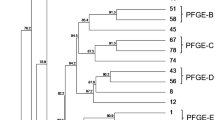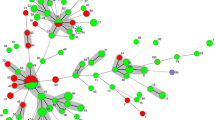Abstract
Recent studies on outbreaks of Candida showed an increased incidence of bloodstream infections in neonatal intensive care units (NICUs) caused by C. parapsilosis species, highlighting the need for the proper identification and epidemiology of these species. Several systems are available for molecular epidemiological and taxonomic studies of fungal infections: pulsed-field gel electrophoresis (PFGE) represents the gold standard for typing, but is also one of the most lengthy and expensive, while simple sequence repeats (SSRs) is based on polymerase chain reaction (PCR) amplification and is, therefore, faster. Only recently, matrix-assisted laser desorption/ionization time-of-flight mass spectrometry (MALDI-TOF MS) has been used to identify and type microorganisms involved in nosocomial outbreaks. In our study, 19 strains of C. parapsilosis isolated from the blood cultures of neonates admitted to the University Hospital Federico II were genotyped by the amplification of eight SSR markers and by MALDI-TOF MS. Electrophoretic and spectrometric profile results were compared in order to identify similarities among the isolates and to study microevolutionary changes in the C. parapsilosis population. The discriminatory power and the unweighted pair group method with arithmetic mean (UPGMA) dendrograms generated were compared in order to evaluate the correlation of the groups established by the analysis of the clusters by both methods. Both methods were rapid and effective in highlighting identical strains and studying microevolutionary changes in the population. Our study evidenced that mass spectroscopy is a useful technique not only for the identification but also for monitoring the spread of strains, which is critical to control nosocomial infections.




Similar content being viewed by others
References
Clerihew L, Lamagni TL, Brocklehurst P, McGuire W (2007) Candida parapsilosis infection in very low birthweight infants. Arch Dis Child Fetal Neonatal Ed 92:F127–F129
Huang YC, Lin TY, Leu HS, Peng HL, Wu JH, Chang HY (1999) Outbreak of Candida parapsilosis fungemia in neonatal intensive care units: clinical implications and genotyping analysis. Infection 27:97–102
Hernández-Castro R, Arroyo-Escalante S, Carrillo-Casas EM, Moncada-Barrón D, Alvarez-Verona E, Hernández-Delgado L, Torres-Narváez P, Lavalle-Villalobos A (2010) Outbreak of Candida parapsilosis in a neonatal intensive care unit: a health care workers source. Eur J Pediatr 169:783–787
Dizbay M, Kalkanci A, Sezer BE, Aktas F, Aydogan S, Fidan I, Kustimur S, Sugita T (2008) Molecular investigation of a fungemia outbreak due to Candida parapsilosis in an intensive care unit. Braz J Infect Dis 12:395–399
García San Miguel L, Pla J, Cobo J, Navarro F, Sánchez-Sousa A, Alvarez ME, Martos I, Moreno S (2004) Morphotypic and genotypic characterization of sequential Candida parapsilosis isolates from an outbreak in a pediatric intensive care unit. Diagn Microbiol Infect Dis 49:189–196
van Asbeck EC, Huang YC, Markham AN, Clemons KV, Stevens DA (2007) Candida parapsilosis fungemia in neonates: genotyping results suggest healthcare workers hands as source, and review of published studies. Mycopathologia 164:287–293
Smith PB, Steinbach WJ, Benjamin DK Jr (2005) Neonatal candidiasis. Infect Dis Clin North Am 19:603–615
Lupetti A, Tavanti A, Davini P, Ghelardi E, Corsini V, Merusi I, Boldrini A, Campa M, Senesi S (2002) Horizontal transmission of Candida parapsilosis candidemia in a neonatal intensive care unit. J Clin Microbiol 40:2363–2369
Posteraro B, Bruno S, Boccia S, Ruggiero A, Sanguinetti M, Romano Spica V, Ricciardi G, Fadda G (2004) Candida parapsilosis bloodstream infection in pediatric oncology patients: results of an epidemiologic investigation. Infect Control Hosp Epidemiol 25:641–645
Romeo O, Delfino D, Costanzo B, Cascio A, Criseo G (2012) Molecular characterization of Italian Candida parapsilosis isolates reveals the cryptic presence of the newly described species Candida orthopsilosis in blood cultures from newborns. Diagn Microbiol Infect Dis 72:234–238
Tortorano AM, Dho G, Prigitano A, Breda G, Grancini A, Emmi V, Cavanna C, Marino G, Morero S, Ossi C, Delvecchio G, Passera M, Cusumano V, David A, Bonaccorso G, Corona A, Favaro M, Vismara C, Garau MG, Falchi S, Tejada MR; ECMM-FIMUA Study Group (2012) Invasive fungal infections in the intensive care unit: a multicentre, prospective, observational study in Italy (2006–2008). Mycoses 55:73–79
Trofa D, Gácser A, Nosanchuk JD (2008) Candida parapsilosis, an emerging fungal pathogen. Clin Microbiol Rev 21:606–625
Douglas LJ (2003) Candida biofilms and their role in infection. Trends Microbiol 11:30–36
Pulcrano G, Panellis D, De Domenico G, Rossano F, Catania MR (2012) Ambroxol influences voriconazole resistance of Candida parapsilosis biofilm. FEMS Yeast Res 12:430–438
Riederer K, Fozo P, Khatib R (1998) Typing of Candida albicans and Candida parapsilosis: species-related limitations of electrophoretic karyotyping and restriction endonuclease analysis of genomic DNA. Mycoses 41:397–402
Tay ST, Na SL, Chong J (2009) Molecular differentiation and antifungal susceptibilities of Candida parapsilosis isolated from patients with bloodstream infections. J Med Microbiol 58:185–191
Enger L, Joly S, Pujol C, Simonson P, Pfaller M, Soll DR (2001) Cloning and characterization of a complex DNA fingerprinting probe for Candida parapsilosis. J Clin Microbiol 39:658–669
Taylor JW, Fisher MC (2003) Fungal multilocus sequence typing—it’s not just for bacteria. Curr Opin Microbiol 6:351–356
Hennequin C, Thierry A, Richard GF, Lecointre G, Nguyen HV, Gaillardin C, Dujon B (2001) Microsatellite typing as a new tool for identification of Saccharomyces cerevisiae strains. J Clin Microbiol 39:551–559
Shemer R, Weissman Z, Hashman N, Kornitzer D (2001) A highly polymorphic degenerate microsatellite for molecular strain typing of Candida krusei. Microbiology 147:2021–2028
Sampaio P, Gusmão L, Alves C, Pina-Vaz C, Amorim A, Pais C (2003) Highly polymorphic microsatellite for identification of Candida albicans strains. J Clin Microbiol 41:552–557
Jarne P, Lagoda PJ (1996) Microsatellites, from molecules to populations and back. Trends Ecol Evol 11:424–429
Fundyga RE, Lott TJ, Arnold J (2002) Population structure of Candida albicans, a member of the human flora, as determined by microsatellite loci. Infect Genet Evol 2:57–68
Sampaio P, Gusmão L, Correia A, Alves C, Rodrigues AG, Pina-Vaz C, Amorim A, Pais C (2005) New microsatellite multiplex PCR for Candida albicans strain typing reveals microevolutionary changes. J Clin Microbiol 43:3869–3876
Lasker BA, Butler G, Lott TJ (2006) Molecular genotyping of Candida parapsilosis group I clinical isolates by analysis of polymorphic microsatellite markers. J Clin Microbiol 44:750–759
Sabino R, Sampaio P, Rosado L, Stevens DA, Clemons KV, Pais C (2010) New polymorphic microsatellite markers able to distinguish among Candida parapsilosis sensu stricto isolates. J Clin Microbiol 48:1677–1682
Claydon MA, Davey SN, Edwards-Jones V, Gordon DB (1996) The rapid identification of intact microorganisms using mass spectrometry. Nat Biotechnol 14:1584–1586
van Veen SQ, Claas EC, Kuijper EJ (2010) High-throughput identification of bacteria and yeast by matrix-assisted laser desorption ionization-time of flight mass spectrometry in conventional medical microbiology laboratories. J Clin Microbiol 48:900–907
Welker M (2011) Proteomics for routine identification of microorganisms. Proteomics 11:3143–3153. doi:10.1002/pmic.201100049
Williamson YM, Moura H, Woolfitt AR, Pirkle JL, Barr JR, Carvalho Mda G, Ades EP, Carlone GM, Sampson JS (2008) Differentiation of Streptococcus pneumoniae conjunctivitis outbreak isolates by matrix-assisted laser desorption ionization-time of flight mass spectrometry. Appl Environ Microbiol 74:5891–5897
Bittar F, Cassagne C, Bosdure E, Stremler N, Dubus JC, Sarles J, Reynaud-Gaubert M, Raoult D, Rolain JM (2010) Outbreak of Corynebacterium pseudodiphtheriticum infection in cystic fibrosis patients, France. Emerg Infect Dis 16:1231–1236
Schlebusch S, Price GR, Hinds S, Nourse C, Schooneveldt JM, Tilse MH, Liley HG, Wallis T, Bowling F, Venter D, Nimmo GR (2010) First outbreak of PVL-positive nonmultiresistant MRSA in a neonatal ICU in Australia: comparison of MALDI-TOF and SNP-plus-binary gene typing. Eur J Clin Microbiol Infect Dis 29:1311–1314
Tavanti A, Davidson AD, Gow NA, Maiden MC, Odds FC (2005) Candida orthopsilosis and Candida metapsilosis spp. nov. to replace Candida parapsilosis groups II and III. J Clin Microbiol 43:284–292
Tenover FC, Arbeit RD, Goering RV, Mickelsen PA, Murray BE, Persing DH, Swaminathan B (1995) Interpreting chromosomal DNA restriction patterns produced by pulsed-field gel electrophoresis: criteria for bacterial strain typing. J Clin Microbiol 33:2233–2239
White E, Sahota R, Edes S (2002) Rapid microsatellite analysis using discontinuous polyacrylamide gel electrophoresis. Genome 45:1107–1109
Andrei A, Zervos MJ (2006) The application of molecular techniques to the study of hospital infection. Arch Pathol Lab Med 130:662–668
Larrasa J, García-Sánchez A, Ambrose NC, Parra A, Alonso JM, Rey JM, Hermoso-de-Mendoza M, Hermoso-de-Mendoza J (2004) Evaluation of randomly amplified polymorphic DNA and pulsed field gel electrophoresis techniques for molecular typing of Dermatophilus congolensis. FEMS Microbiol Lett 240:87–97
Soll DR (2000) The ins and outs of DNA fingerprinting the infectious fungi. Clin Microbiol Rev 13:332–370
Shin JH, Shin DH, Song JW, Kee SJ, Suh SP, Ryang DW (2001) Electrophoretic karyotype analysis of sequential Candida parapsilosis isolates from patients with persistent or recurrent fungemia. J Clin Microbiol 39:1258–1263
Diekema DJ, Messer SA, Hollis RJ, Wenzel RP, Pfaller MA (1997) An outbreak of Candida parapsilosis prosthetic valve endocarditis. Diagn Microbiol Infect Dis 29:147–153
Zancopé-Oliveira RM, James MJ, Derossi AP, Sampaio JLM, Muniz MM, Li RK, Nascimento ASA, Peralta JM, Reiss E (2000) Strain characterization of Candida parapsilosis fungemia by molecular typing methods. Eur J Clin Microbiol Infect Dis 19:514–520
Vaz C, Sampaio P, Clemons KV, Huang YC, Stevens DA, Pais C (2011) Microsatellite multilocus genotyping clarifies the relationship of Candida parapsilosis strains involved in a neonatal intensive care unit outbreak. Diagn Microbiol Infect Dis 71:159–162
Boriollo MF, Dias RA, Fiorini JE, Oliveira Nde M, Spolidório DM, de Souza HM, Figueira AV, Pizzirani-Kleiner AA (2010) Disparity between multilocus enzyme electrophoresis, microsatellite markers and pulsed-field gel electrophoresis in epidemiological tracking of Candida albicans. J Microbiol Methods 82:265–281
Shin JH, Park MR, Song JW, Shin DH, Jung SI, Cho D, Kee SJ, Shin MG, Suh SP, Ryang DW (2004) Microevolution of Candida albicans strains during catheter-related candidemia. J Clin Microbiol 42:4025–4031
Spanu T, Posteraro B, Fiori B, D’Inzeo T, Campoli S, Ruggeri A, Tumbarello M, Canu G, Trecarichi EM, Parisi G, Tronci M, Sanguinetti M, Fadda G (2012) Direct MALDI-TOF mass spectrometry assay of blood culture broths for rapid identification of Candida species causing bloodstream infections: an observational study in two large microbiology laboratories. J Clin Microbiol 50:176–179
Pinto A, Halliday C, Zahra M, van Hal S, Olma T, Maszewska K, Iredell JR, Meyer W, Chen SC (2011) Matrix-assisted laser desorption ionization-time of flight mass spectrometry identification of yeasts is contingent on robust reference spectra. PLoS One 6:e25712
Lockhart SR, Fritch JJ, Meier AS, Schröppel K, Srikantha T, Galask R, Soll DR (1995) Colonizing populations of Candida albicans are clonal in origin but undergo microevolution through C1 fragment reorganization as demonstrated by DNA fingerprinting and C1 sequencing. J Clin Microbiol 33:1501–1509
Metzgar D, van Belkum A, Field D, Haubrich R, Wills C (1998) Random amplification of polymorphic DNA and microsatellite genotyping of pre- and posttreatment isolates of Candida spp. from human immunodeficiency virus-infected patients on different fluconazole regimens. J Clin Microbiol 36:2308–2313
Perepnikhatka V, Fischer FJ, Niimi M, Baker RA, Cannon RD, Wang YK, Sherman F, Rustchenko E (1999) Specific chromosome alterations in fluconazole-resistant mutants of Candida albicans. J Bacteriol 181:4041–4049
Conflict of interest
The authors declare that they have no conflict of interest.
Author information
Authors and Affiliations
Corresponding author
Rights and permissions
About this article
Cite this article
Pulcrano, G., Roscetto, E., Iula, V.D. et al. MALDI-TOF mass spectrometry and microsatellite markers to evaluate Candida parapsilosis transmission in neonatal intensive care units. Eur J Clin Microbiol Infect Dis 31, 2919–2928 (2012). https://doi.org/10.1007/s10096-012-1642-6
Received:
Accepted:
Published:
Issue Date:
DOI: https://doi.org/10.1007/s10096-012-1642-6




